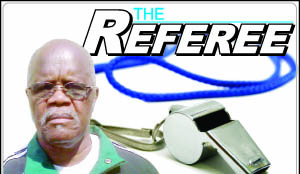 Preamble:
Preamble:
SINCE the initial edition of The Referee Column which was published in the Sunday Times of Zambia dated October 6, 2013, the column has been running weekly since then.
In football there are 17 laws which govern the game and so far 16 have been adequately explained and not in the sequence in which they appear in the Law booklet.
Today’s episode is the last Law but not the end of your favourite column. The column will continue with the topics which are not Laws of the Game per se but matters connected with or incidental to the Laws of the Game. These matters in football refereeing are known as “factors to effective match control.”
Coming back to today’s edition, the balls to be used in any match are supplied by the host Football Association and/or the Club on which ground the match is played.
Therefore, the match balls used in any match shall be considered the properties of the Football Association or Club on whose ground the match is played. At the close of play, the balls must be returned to the Referee who subsequently must take them back to the hosts.
The International Football Association Board, from time to time, decides what constitutes approved materials. Any approved material shall be certified as such under the International Football Association Board (IFAB) Decision 1 below.
Law 1: The Match Ball:
Qualities and Measurements:
The Ball is:
* Spherical and made of leather or other suitable material,
* Of a circumference of not more than 70 cm (28 ins) and not less than 68 cm (27 ins),
* Not more than 450 g (16 oz) and not less than 410 g (14 oz) in weight at the start of the match,
* Of a pressure equal to 0.6 – 1.1 atmosphere (600 – 1,100 g/cm2) at sea level (8.5 lbs/sq in) at the start of the match.
The emphasis is at the start of the match because the balls do not keep to the above specifications throughout the match in particular due to adverse weather conditions.
Replacement of Defective Ball:
If the ball bursts or becomes defective during the course of a match:
* The match is stopped,
* The match is restarted by dropping the replacement ball at the place where the original ball became defective, unless play was stopped inside the goal-area, in which case the Referee drops the replacement ball on the goal-area line parallel to the goal-line at the point nearest to where the original ball was located when play was stopped.
If the ball bursts or becomes defective during a penalty-kick or during kicks from the penalty-mark as it moves forward and before it touches any player or the cross-bar or goal-posts:
* The penalty-kick is retaken.
If the ball bursts or becomes defective whilst not in play at a kick-off, goal-kick, corner-kick, penalty-kick or throw-in:
* The match is restarted accordingly.
The ball may not be changed during the match without the authority of the Referee.
Additional Balls:
Additional balls may be placed around the field of play for use during a match provided that they meet the requirements of Law 2 and their use under the control of the Referee.
Decisions of the International Football Association Board:
Decision 1:
In addition to the requirements of Law 2, acceptance of a ball for use in matches played in an official competition organised under the auspices of FIFA or the Confederations is conditional upon the ball bearing one of the following:
* The official “FIFA APPROVED” logo,
* The official “FIFA INSPECTED” logo,
* The “INTERNATIONAL MATCHBALL STANDARD” logo.
Such a logo on a ball indicates that it has been tested officially and found to be in compliance with the specific technical requirements, different for each logo and additional to the minimum specifications stipulated in Law 2. The list of the additional requirements specific to each of the respective logos must be approved by the International Football Association Board. The institutes conducting the tests are subject to the approval of FIFA.
Member Football Associations competitions may also require the use of balls bearing any one of the above three logos.
Decision 2:
In matches played in an official competition organised under the auspices of FIFA, the Confederations e.g. CAF or Member Football Association e.g. FAZ, no form of commercial advertising on the ball is permitted, except for the emblem of the competition, the competition organizer and the authorised trademark of the manufacturer.
The Competition Rules and Regulations may restrict the size and number of such markings on the ball.
Decision 3:
Where goal-line technology (GLT) is used, ball with integrated technology are allowed, but they must either be “FIFA APPROVED”, “FIFA INSPECTED” or “INTERNATIONAL MATCHBALL STANDARD” as per Decision 1 above.
Chileshe_mukuka@yahoo.co.uk or 0966/0978 759558






